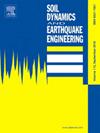Reusability of damping behavior in friction damper using brake pads: Experimental evaluation under repeated loading without intervening maintenance
IF 4.6
2区 工程技术
Q1 ENGINEERING, GEOLOGICAL
引用次数: 0
Abstract
Over the past decade, friction dampers have been increasingly integrated into structural components to mitigate seismic damage and reduce post-earthquake repair costs, aiming to enhance the seismic resilience of infrastructure. A critical demand in this context is the application of optimized friction shims that could prevent wear on the contacting metallic surface and exhibit reliable reusability of damping behavior under repeated loading without requiring maintenance. Inspired by the fact that brake pads do not damage the wheel surfaces, this study investigatesd the feasibility of using three types of brake pad materials as friction shim in friction damper: (a) Phenolic resins with aramid fiber (PRAF); (b) Phenolic resins with fine iron wire/steel fiber (PRIW); (c) Iron-based powder metallurgy (PM). These brake pads were installed in a symmetric friction damper and tested under two initial average contact pressures: 8.93 MPa and 14.88 MPa. Therefore, six specimens were assembled. A loading protocol with a constant loading velocity of 5 mm/s, including 42 loading cycles, was adopted. The loading protocol was executed twice to evaluate the reusability of the damping behavior in these specimens. Notably, there was a time interval between these two loading sequences during which no maintenance operations were performed to simulate mainshock-aftershock earthquake sequences. The bolt force fluctuation, temperature variation, and stability in the friction coefficient and friction strength across both loading sequences were examined. The results showed that: (a) These brake pads did not cause wear damage to the contacted metallic surface; (b) Compared with aramid fiber, the iron wire/steel fiber was more effective in improving friction coefficient; (c) The friction coefficient and friction strength of the specimens using PM was increasing gradually during the initial sliding due to the break-in phase. The specimens using PM exhibited the highest friction strength and energy dissipation after completing the break-in phase compared to those using PRAF or PRIW; and (d) Specimens equipped with PRAF or PRIW had satisfactory reusability in terms of friction strength, fatigue resistance, and energy dissipation.
使用刹车片的摩擦减振器阻尼行为的可重复使用性:重复加载下无干预维护的实验评估
在过去的十年中,摩擦阻尼器越来越多地集成到结构部件中,以减轻地震破坏和降低震后修复成本,旨在提高基础设施的抗震能力。在这种情况下,一个关键的需求是应用优化的摩擦垫片,它可以防止接触金属表面的磨损,并在重复加载下表现出可靠的可重复使用的阻尼行为,而无需维护。受刹车片不会损坏车轮表面这一事实的启发,本研究调查了使用三种类型的刹车片材料作为摩擦减振器摩擦片的可行性:(a)酚醛树脂与芳纶纤维(PRAF);(b)带有细铁丝/钢纤维的酚醛树脂;(c)铁基粉末冶金。这些刹车片安装在对称摩擦阻尼器中,并在两种初始平均接触压力下进行测试:8.93 MPa和14.88 MPa。因此,组装了6个标本。加载方案为加载速度为5 mm/s,加载周期为42个。加载方案执行了两次,以评估这些试件阻尼行为的可重用性。值得注意的是,在这两个加载序列之间存在一个时间间隔,在此期间没有进行维护操作来模拟主震-余震地震序列。考察了两种加载方式下螺栓受力波动、温度变化以及摩擦系数和摩擦强度的稳定性。结果表明:(a)这些刹车片没有对接触的金属表面造成磨损损伤;(b)与芳纶纤维相比,铁丝/钢纤维改善摩擦系数更有效;(c)在初始滑动阶段,由于磨合阶段的原因,PM试样的摩擦系数和摩擦强度逐渐增大。与PRAF和PRIW相比,PM的摩擦强度和能量耗散最高;(d)在摩擦强度、抗疲劳性能和能量耗散方面,PRAF和PRIW均具有良好的重复使用性。
本文章由计算机程序翻译,如有差异,请以英文原文为准。
求助全文
约1分钟内获得全文
求助全文
来源期刊

Soil Dynamics and Earthquake Engineering
工程技术-地球科学综合
CiteScore
7.50
自引率
15.00%
发文量
446
审稿时长
8 months
期刊介绍:
The journal aims to encourage and enhance the role of mechanics and other disciplines as they relate to earthquake engineering by providing opportunities for the publication of the work of applied mathematicians, engineers and other applied scientists involved in solving problems closely related to the field of earthquake engineering and geotechnical earthquake engineering.
Emphasis is placed on new concepts and techniques, but case histories will also be published if they enhance the presentation and understanding of new technical concepts.
 求助内容:
求助内容: 应助结果提醒方式:
应助结果提醒方式:


